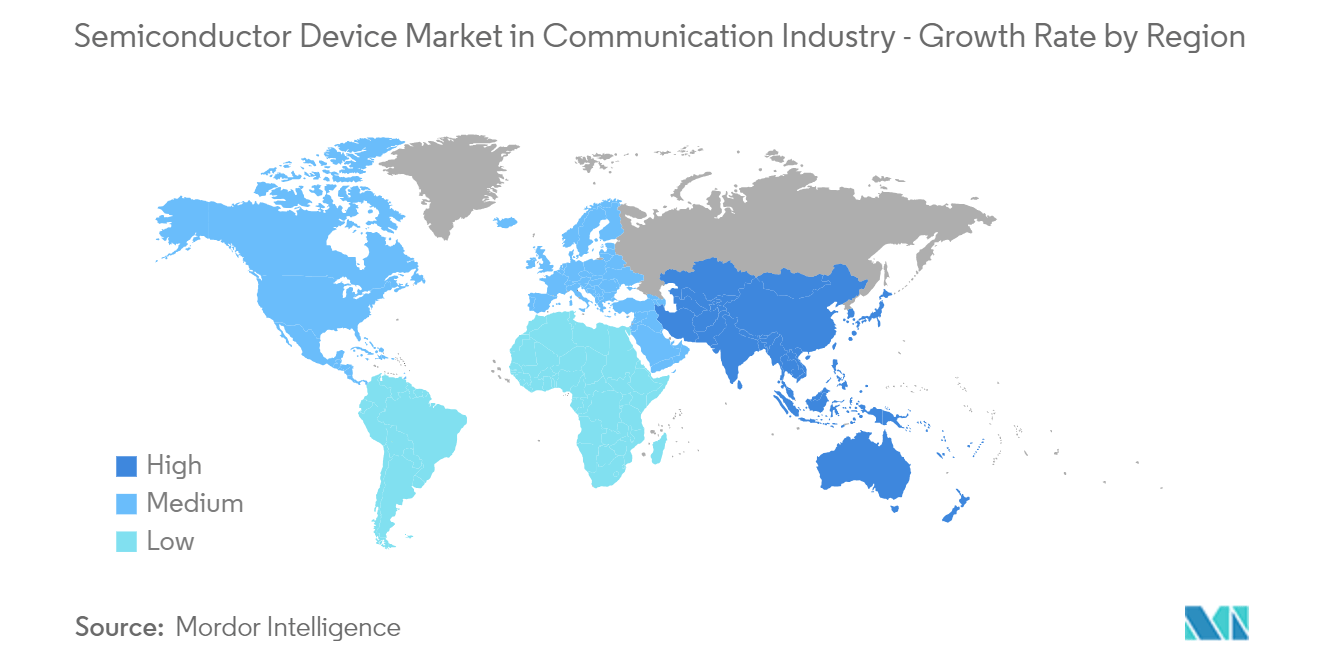Market Trends of Semiconductor Device Industry In Communication Industry
Growing Adoption of 5G Technology
- The increasing implementation of 5G has resulted in a significant demand for 5G-enabled devices like smartphones, which, in turn, drives the demand for the semiconductor device market in the communication industry.
- Ericsson forecasts that there will be 4.4 billion 5G subscriptions across the globe by the end of 2027, accounting for 48% of all mobile subscriptions. As per the company, 5G subscription uptake is faster than that of 4G following its launch in 2009, reaching 1 billion subscriptions two years earlier than 4G did.
- Key factors include the timely availability of devices from several vendors, with prices falling faster than 4G, and China's large, early 5G deployments. According to Ericsson, 5G will become the dominant mobile access technology by subscriptions in 2027.
- The improved 5G network and unlimited data plans will attract more 5G subscribers across the globe. Video-based apps, virtual/augmented reality, and gaming generate huge data traffic. According to GSMA, 5G subscriptions in North America will be more than 90%, the highest among all regions.
- Moreover, the deployment of 5G networks is increasing the demand for data centers. This is because 5G networks require a significant amount of data processing and storage capabilities to provide high-speed, low-latency connections to end users.
- Furthermore, in February 2023, GSMA reported that 5G connections are anticipated to double over the upcoming two years. In addition, GSMA also reported that the growth would come from key markets within APAC and LATAM, like Brazil and India, which have recently launched 5G networks. India will be particularly significant, with the expansion of services from Jio and Airtel in 2023 expected to be key to continued adoption in the region. Moreover, as per GSMA, 5G is anticipated to account for 145 million in India by the end of 2025.

Asia-Pacific to Hold Significant Market Share
- The emergence of different technologies, including the introduction of smartphones, tablets, and a variety of cloud-based services, has driven a steady increase in demand for faster and more pervasive personal mobile communication systems. This, in turn, has resulted in the introduction of a growing variety of wireless base stations (BTS), creating the connection points between the mobile terminals and the main wired network.
- The rapid growth of the IT sector and industrialization are also driving the demand for the semiconductor device market in the communications industry in the Asia-Pacific region. These sectors will greatly facilitate foreign investment, increasing the region's exposure to developed countries and new technologies. The private and public sectors are continuously investing heavily in developing the region's telecommunications industry, as the availability of high-speed and efficient telecommunications networks is essential for the growth of these sectors.
- The Japanese telecommunications industry is among the largest in the world in terms of revenue. Few major fixed and mobile network operators have invested heavily in towers and IT infrastructure over the past two decades despite the overall market being fueled by slow economic and demographic growth. 5G adoption is also gaining traction in the country, and Japan aims to reach almost full 5G coverage by the end of 2030.
- Moreover, the Indian communication industry has been witnessing sharp growth driven by a growing subscriber base and the liberal and reformist government approach towards the industry. For instance, according to IBEF, India is among the world's second-largest telecommunications markets, with a subscriber base of 1.16 billion until April 2022. Furthermore, in April-June 2022, the total number of internet subscribers in India reached 836.86 million. Additionally, the wireless segment accounted for 95.4% of the total telephone subscriptions In June 2022.
- Additionally, the Indian government has started to focus significantly on developing a solid digitized economy and is taking several initiatives to promote the adoption of digital technologies; this, in turn, is aiding the growth of the semiconductor device market in the communication industry in the region.
- Increasing the number of data centers may also offer massive opportunities for companies operating in the semiconductor device market in the communication industry. For instance, in March 2023, OVH Cloud announced the launch of its first data center in India as a part of its Asia Pacific expansion plan. The company will also deploy two additional data centers in Australia and Singapore by next year. Similarly, in June 2022, ST Telemedia Global Data Centers (STT GDC) announced its plans for a new data center site in South Korea.


